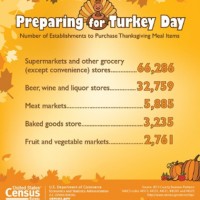By the numbers: Turkey Day
In the fall of 1621, the Pilgrims — early settlers of Plymouth Colony — held a three-day feast to celebrate a bountiful harvest. This event is regarded by many as the nation's firstThanksgiving. The Wampanoag Indians in attendance played a key role. Historians have recorded ceremonies of thanks among other groups of European settlers inNorth America. These include the British colonists inVirginiaas early as 1619.
The legacy of thanks and the feast have survived the centuries, as the event became a national holiday 152 years ago (Oct. 3, 1863) when PresidentAbraham Lincolnproclaimed the last Thursday of November as a national day ofthanksgiving. Later, PresidentFranklin Rooseveltclarified thatThanksgivingshould always be celebrated on the fourth Thursday of the month to encourage earlier holiday shopping, never on the occasional fifth Thursday.
Where to Feast
117 million: Number of occupied housing units across the nation in the second quarter of 2015 — all potential stops for Thanksgivingdinner.
Source: U.S. Census Bureau, Housing Vacancies and Homeownership, Table 8 http://www.census.gov/housing/hvs/data/histtabs.html
4.5 million: Number of multigenerational households in the U.S. in 2014. It is possible these households, consisting of three or more generations, will have to purchase large quantities of food to accommodate all the family members sitting around the table for the holiday feast — even if there are no guests!
Source: 2014 American Community Survey, Table B11017
http://factfinder.census.gov/faces/tableservices/jsf/pages/productview.xhtml?pid=ACS_14_1YR_B11017&prodType=table
4: Number of places inthe United Statesnamed after the holiday's traditional main course. Turkey Creek Village, La., was the most populous in 2014, with 443 residents, followed by Turkey Creek, Ariz. (412), Turkey City, Texas(396) and Turkey Town, N.C. (296). There are also 11 townships in the U.S. with "Turkey" in the name. (Please note that the Turkey Creek, Ariz., population total pertains to the 2009-2013 American Community Survey and is not statistically different from the population estimates of the other three places.)
Sources: U.S. Census Bureau, 2014 Population Estimates
http://www.census.gov/popest/data/cities/totals/2014/index.html
http://www.census.gov/geo/maps-data/data/gazetteer.html
U.S. Census Bureau, 2009-2013 American Community Survey
http://factfinder.census.gov/bkmk/table/1.0/en/ACS/13_5YR/B01003/1600000US0477415
7: Number of places and townships inthe United Statesthat are named Cranberry, a popular side dish at Thanksgiving. Cranberry township (Butler County), Pa., was the most populous of these places in 2014, with 30,170 residents. Cranberry township (Venango County), Pa., was next (6,546).
Sources: U.S. Census Bureau, 2013 Population Estimates and 2010 Census Summary File 1 http://www.census.gov/popest/data/cities/totals/2014/index.html
http://www.census.gov/geo/maps-data/data/gazetteer.html
32: Number of counties, places and townships inthe United StatesnamedPlymouth, as in Plymouth Rock, the landing site of the first Pilgrims. The two counties, both namedPlymouth, are inMassachusetts(507,022) and Iowa(24,874).
Plymouth, Minn., is the most populous place, with 75,057 residents in 2014. There are two places inthe United Statesnamed Pilgrim: one, a township inDade County, Mo., had a population of 129; the other, a census designated place inMichigan, had a population of 36. And then there isMayflower, Ark., whose population was 2,345, andMayflower Village, Calif., whose population was 5,662.
Note: Townships have been included in these counts from 12 states (Connecticut,Maine,Massachusetts, Michigan,Minnesota,New Hampshire,New Jersey,New York,Pennsylvania,Rhode Island,Vermontand Wisconsin) where the primary governmental or administrative divisions of a county serve as general-purpose local governments that can perform the same governmental functions as incorporated places. These county subdivisions are known as minor civil divisions, and the Census Bureau presents data for these in all products for which place data are provided.
(Please note that population totals for the two places on the list that are census designated places — Pilgrim, Mich., andMayflower Village, Calif. — pertain to the 2009-2013 American Community Survey.)
Sources: U.S. Census Bureau, Vintage 2014 Population Estimates
http://www.census.gov/popest/data/counties/asrh/2014/index.html
http://www.census.gov/popest/data/cities/totals/2014/index.html
http://www.census.gov/geo/maps-data/data/gazetteer.html
U.S. Census Bureau, 2009-2013 American Community Survey
http://factfinder.census.gov/bkmk/table/1.0/en/ACS/13_5YR/B01003/1600000US0646436
http://factfinder.census.gov/bkmk/table/1.0/en/ACS/13_5YR/B01003/1600000US2664100
Participants in the First Feast
24.4 million: Number of U.S. residents of English ancestry as of 2014. Some could very well be descendants of thePlymouth colonists who participated in the autumn feast that is widely believed to be one of the first Thanksgivings — especially the 655,000 living inMassachusetts.
Source: 2014 American Community Survey, Table B04006
http://factfinder.census.gov/bkmk/table/1.0/en/ACS/14_1YR/B04006
6,500: Number of members of the Wampanoag American Indian tribal grouping, as of 2010, roughly half of whom reside inMassachusetts. The Wampanoag, the American Indians in attendance, played a lead role in this historic encounter, and they had been essential to the survival of the colonists during the newcomers' first year. The Wampanoag are a people with a sophisticated society who have occupied the region for thousands of years. They have their own government, their own religious and philosophical beliefs, their own knowledge system, and their own culture. They are also a people for whom giving thanks was a part of daily life.
Sources: 2010 Census American Indian and Alaska Native Summary File, Table DP-1
http://www.census.gov/population/www/cen2010/cph-t/t-6tables/TABLE%20(1).pdf
American Indian Perspectives onThanksgiving, National Museum of the American Indian http://nmai.si.edu/sites/1/files/pdf/education/thanksgiving_poster.pdf
Preparing the Feast … Enjoying the Day … and the Aftermath
98.6%: Percentage of households in 2011 with a gas or electric stove — essential for cooking theirThanksgivingfeast. Another 96.8 percent had a microwave, also helpful in preparing the meal.
Source: Extended Measures of Well-Being: Living Conditions inthe United States: 2011,
Table 3http://www.census.gov/prod/2013pubs/p70-136.pdf
98.3%: Percentage of households with a television in 2011. No doubt, many guests either before, after or perhaps even during the feast will settle in front of their TVs to watch some football.
Source: Extended Measures of Well-Being: Living Conditions inthe United States: 2011,
Table 3http://www.census.gov/prod/2013pubs/p70-136.pdf
35.8%: Percentage of households with a stand-alone food freezer in 2011, which they may want to use to preserve theirThanksgivingleftovers. Far more (99.2 percent) have a refrigerator. Once all the guests leave, it will be time to clean up. Fortunately, 69.3 percent have a dishwasher to make the task easier.
Source: Extended Measures of Well-Being: Living Conditions inthe United States: 2011,
Table 3http://www.census.gov/prod/2013pubs/p70-136.pdf
Culinary Delights
66,286: The number of supermarkets and other grocery (except convenience) stores inthe United Statesin 2013. These establishments are expected to be extremely busy aroundThanksgivingas people prepare for their delightful meals.
Source: U.S. Census Bureau, 2013 County Business Patterns, NAICS Code 44511
http://factfinder.census.gov/bkmk/table/1.0/en/BP/2013/00A1//naics~44511
3,235: The number of baked goods stores inthe United Statesin 2013 — a potential place to visit to purchase tasty desserts.
Source: U.S. Census Bureau, 2013 County Business Patterns, NAICS Code 445291
http://factfinder.census.gov/bkmk/table/1.0/en/BP/2013/00A1//naics~445291
2,761: The number of fruit and vegetable markets inthe United Statesin 2013 — a great place to find holiday side dishes.
Source: U.S. Census Bureau, 2013 County Business Patterns, NAICS Code 445230
http://factfinder.census.gov/bkmk/table/1.0/en/BP/2013/00A1//naics~445230
228 million: The forecast for the number of turkeysthe United Stateswill raise in 2015. That is down 4 percent from the number raised during 2014.
Source: USDA National Agricultural Statistics Service http://www.nass.usda.gov/Publications/Todays_Reports/reports/tuky0915.pdf
40.0 million: The forecast for the number of turkeysMinnesotawill raise in 2015. The Gopher State was tops in turkey production, followed byNorth Carolina(29 million),Arkansas(27 million),Indiana(19.1 million),Missouri(18 million) andVirginia(17.4 million).
Source: USDA National Agricultural Statistics Service
http://www.nass.usda.gov/Publications/Todays_Reports/reports/tuky0915.pdf
$24 million: The value of U.S. imports of live turkeys for 2014, with 100 percent of them coming fromCanada. When it comes to sweet potatoes, theDominican Republicwas the source of 48.8 percent ($6.6 million) of total imports ($13.6 million).The United Statesran a$16.5 milliontrade deficit in live turkeys during the period but had a surplus of$98.3 millionin sweet potatoes.
Source: U.S. Census Bureau, Economic Indicators Division
https://usatrade.census.gov/
841 million pounds: The forecast for U.S. cranberry production in 2015.Wisconsinwas estimated to lead all states in the production of cranberries, with 503 million pounds, followed byMassachusetts(estimated at 211 million).New Jersey, OregonandWashingtonwere also estimated to have substantial production, ranging from 18 million to 59 million pounds.
Source: USDA National Agricultural Statistics Service
http://www.nass.usda.gov/Statistics_by_State/New_Jersey/Publications/Current_News_Release/Cran2015.pdf
3.0 billion pounds: The total weight of sweet potatoes — another popularThanksgivingside dish — produced by major sweet potato producing states in 2014.
Source: USDA National Agricultural Statistics Service
http://www.nass.usda.gov/Data_and_Statistics


